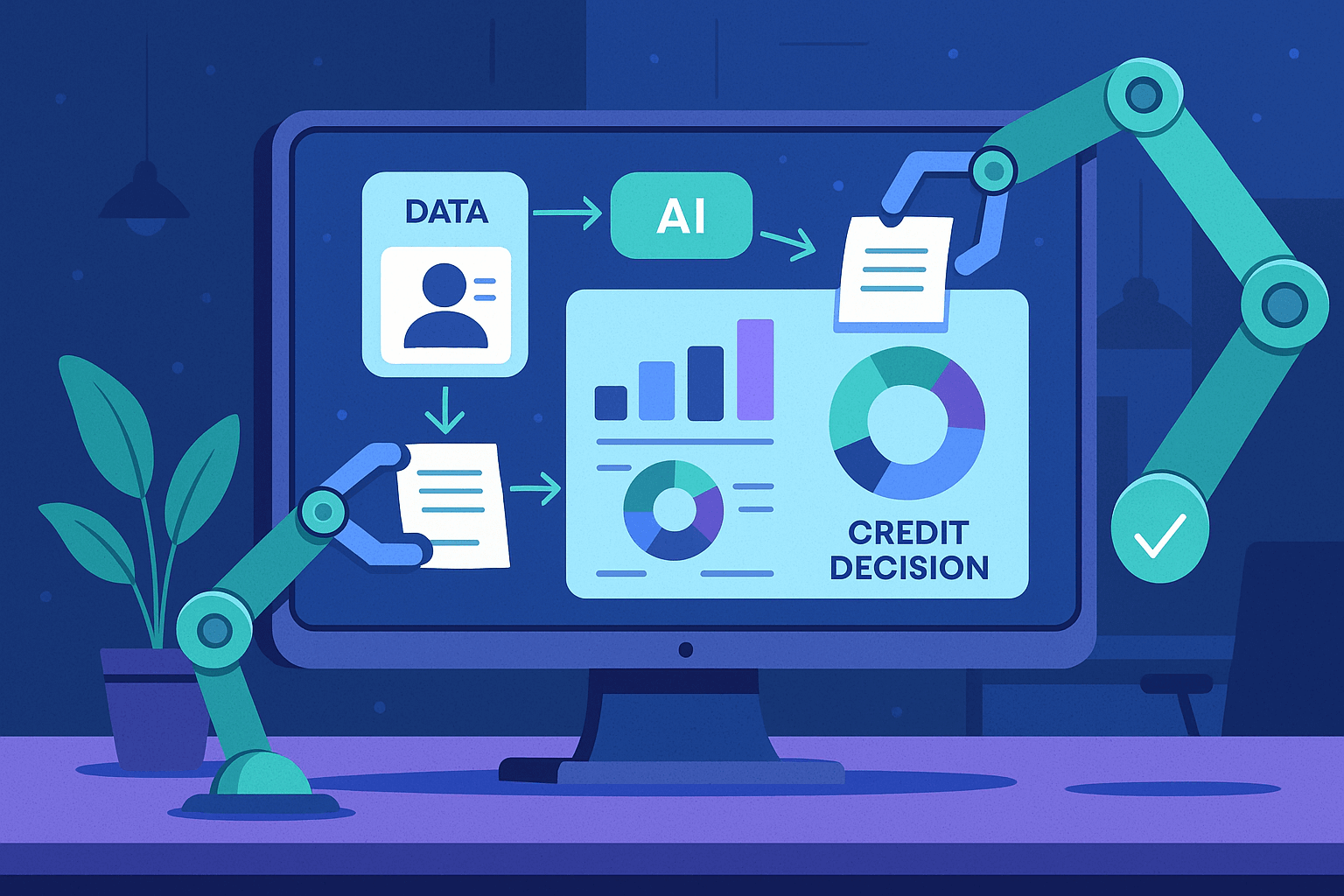What would your team look like if credit reviews no longer depended on paperwork and manual checks?
It is a question many funders are asking as they look for ways to move faster and handle more applications without driving up costs.
Manual processes can feel familiar, but they slow everything down. Automated solutions, on the other hand, can bring speed, accuracy, and the ability to focus on real decision-making to your team.
In this article, we’ll explore how automation works in the credit decision-making process and why it's worth your time and investment.
What Does Automation in Credit Decisions Mean?
The typical lending process starts with the onboarding process, where a business shares its financial data, such as bank statements, with a funder or a broker.
From there, the funder has to check documents, review cash flow, check for existing debt, and decide how much credit they can extend.
In the past, this took a lot of manual labor, from checking each document one by one to rekeying data into CRMs. Today, credit automation can make these steps smoother and faster for financial institutions.
Automation in credit decisioning means the use of software to handle the manual, time-consuming parts of the lending process and streamline workflows.
Routine tasks such as document processing or data checks are automated using software and other automation tools, and the funder can cut down on delays and keep up with modern operational demands.
The automation software can also analyze revenue patterns, flag potential document fraud, and give funders a clear view of a business’s financial health.
What Technologies Are Used for Automating Credit Decisions?
Many funders are now leveraging automation technology to manage loan processing. They're moving away from the traditional manual paperwork and long reviews to a much more efficient credit decision-making process using document automation platforms and other tools.
Here are the main technologies that support automation in the credit decision-making process.
Artificial Intelligence and Machine Learning
Artificial intelligence (AI) and machine learning (ML) are used to study borrower data and large sets of data points.
For example, AI can review months of business bank statements, cash flow history, and repayment patterns within minutes.
This helps funders extend credit quickly, reduce manual reviews, and make better predictions about repayment risks.
Digital Document Management
Digital document management handles document collection, bank statement verification, and storage in a secure system.
When a business uploads tax records or financial statements, the system automatically checks completeness, verifies details, and prepares the data for underwriting.
This saves time, reduces manual data entry, and helps brokers and funders move applications forward without chasing missing files.
Workflow Automation Tools
Workflow automation keeps every part of loan processing connected in one system. Once financial data is verified, the platform can trigger the next step, notify underwriters, and prepare disbursement tasks automatically.
For example, if a borrower is approved, the system can alert the funding team and start the underwriting process.
This automated process helps providers avoid bottlenecks and meet the fast turnaround expectations in SMB finance.
Predictive Analytics
Predictive analytics examines past financial data to forecast repayment behavior. For instance, it can detect seasonal revenue drops or past late payments that may impact a borrower’s ability to repay.
With these insights, funders can adjust loan terms or set repayment schedules that align with a business’s financial health. This strengthens risk management while still allowing for quick funding decisions.
Robotic Process Automation
Robotic process automation (RPA) is designed for repetitive, rule-based tasks. It can handle data entry, send borrower updates, or run compliance checks in the background.
RPA can automatically pull details from a business bank statement and update the credit system, freeing staff to focus on building relationships or handling complex cases.
Optical Character Recognition (OCR)
OCR converts scanned documents and images into machine-readable text. This is useful when brokers or businesses submit files in different formats.
A scanned PDF of a tax return can be read by OCR, and the numbers can be added directly into the underwriting system.
Modern OCR solutions also use AI to improve accuracy, spot patterns, and support multiple languages, giving funders faster document verification and fewer errors during onboarding.
Intelligent Document Processing (IDP)
Intelligent document processing combines OCR, AI, and machine learning to understand and extract data from complex documents.
For example, IDP can read bank statements with multiple pages, spot irregularities, and pull only the needed data points into the loan system.
It can also classify documents by type, apply your pre-set business rules to flag inconsistencies, and filter files based on your polices.
How Credit Decision Automation Works
Credit decision automation works by turning the most repetitive parts of the loan origination cycle into automated workflows. These parts usually include document intake, scrubbing, and rekeying financial data into your CRM or other software.
With high-volume funders receiving thousands of documents per day, doing everything manually will slow down approvals and increase the chance of errors.
Let's discuss in detail how automation tools can take care of these manual processes for you:
Application Submission
Document intake starts when a small business applies through a digital portal, mobile app, or email.
Business information, business bank statements, and financial data are uploaded directly into the system. OCR tools convert scanned files, such as PDFs of business bank statements, into machine-readable text, eliminating the need for staff to retype details.
The system then classifies files by type, for example, separating monthly statements from IDs, and organizes them for review.
This step creates a complete digital package of the applicant’s data that can move straight into validation.
Document Parsing
Automated systems pull structured data out of financial documents. This means scrubbing data such as daily deposits, withdrawals, and ending balances from business bank statements.
OCR combined with machine learning makes it possible to handle inconsistent layouts, poor-quality scans, or handwritten notes.
The parser also checks for duplicate files, flags missing pages, and validates that deposits add up correctly. This ensures the extracted data points are clean before underwriting begins.
Validation
The tool then takes the parsed data and adds context from internal and third-party services or credit bureaus. For example, NAICS codes may be added to classify the business type, or licensing and registration information may be pulled in from state databases.
Cash flow figures can also be normalized so that revenue patterns are expressed consistently across different banks.
This enriched data package gives MCA funders a fuller profile of the applicant before risk checks are applied.
Applying Business Criteria
At this stage, the system applies your pre-set business rules. Automated checks filter applicants based on standard operating procedures, such as minimum monthly revenue, overdraft frequency, or active liens.
For instance, if daily deposits fall below a set threshold or if debt-to-revenue ratios exceed policy limits, the application is flagged.
These checks reduce rework downstream and make sure each application follows the provider’s risk framework.
Analytics
The tool then pulls out the financial and operational metrics that drive credit decisions, often buried inside documents.
This includes average daily deposits, loss ratios, risk exposures, and other relevant metrics your underwriters need to review.
It can highlight patterns, flag potential risks, and provide a full picture of a borrower’s financial health. With these insights, underwriters can make faster and more accurate credit decisions.
Connects with Your Existing Credit Management Systems
The final stage is relay, where all structured data flows into the funder’s loan origination software, CRM, or internal database. No CSV uploads or manual rekeying are needed.
For example, once an application passes checks, the system pushes normalized revenue figures and borrower details straight into the underwriting platform, keeping every system aligned for the next step in the funding process.
Why Funders Benefit From Automated Credit Decisions
Responsible credit management is all about finding ways to improve your credit workflows.
But what does automation really offer your business? Is it worth the investment? The effort to move away from the processes you and your team have done for years?
Let's look at key benefits that make automation worth it for funders.
Less Manual Work
One of the biggest gains comes from speed. Automated systems can handle data entry, document checks, and identity confirmation in minutes.
For example, when a business submits six months of bank statements, the system can read them, classify them, and extract relevant data without human review.
With higher operational efficiency, your teams are no longer tied up by manual processes. The same group of people can move more files through the pipeline in less time.
Improved Accuracy and Consistency
Manual processes often lead to errors, especially when teams are handling large volumes of applications.
Modern platforms now process close to 90% of bank statements with more than 99% accuracy, and they do it in less than a minute.
If a document cannot be parsed, the system signals that right away so the team can make other arrangements.
Once the data is parsed, it is enriched and displayed in a dashboard that makes it easy to calculate metrics such as true revenue, balance analytics, NSF days, and DSCR.
Funders can also set underwriting criteria, such as a minimum revenue requirement or a limit on NSF days, and the system will show in real time if an applicant qualifies.
Reduced Credit Risk
Risk analysis becomes stronger when it is powered by automation. Automated systems can combine a borrower’s credit score with cash flow data and repayment history to highlight potential problems.
For example, if a borrower shows strong monthly deposits but also frequent overdrafts, the system flags the risk for manual review.
By handling the bulk of analysis automatically, staff can focus on complex cases that need human judgment, reducing blind spots in decision-making.
Scalable Growth
Growing with manual processes usually means hiring more people, and that pushes up operational costs.
Automation changes the story. With the right system in place, funders can take on more applications without adding more staff.
Here’s the reality: it can take a human about 20 minutes to process one submission. Add to that more than 100 separate steps in the workflow, and you can see why growth feels slow and messy.
Even tools like RPA, OCR, or IDP only solve parts of the problem. Many funders turn to business process outsourcing, which has become a $300 billion global spend, just to keep up.
When funders rely on automation, those bottlenecks start to disappear. The system can handle larger volumes, and teams can keep working at the same pace without being buried in paperwork.
So if a funder expands into a new region or market, the infrastructure is already there to support the extra intake. That’s how growth happens without operational costs spiraling out of control.
How to Begin Automating Credit Decisions
Getting started with credit decision automation does not have to feel overwhelming. Here are some easy steps we suggest to help you move in the right direction.
Map Your Current Processes
Start by laying out every step of your credit decision-making process, from intake to servicing.
Identify where manual processes slow things down, such as collecting financial documents, rekeying borrower details, or sending emails between teams.
Mapping this out helps you see bottlenecks clearly and shows where minimal manual intervention can make the biggest difference.
Set Clear Objectives
It is important to know what you want automation to achieve.
Your goals might include faster credit approvals, reducing operational costs, improving accuracy in risk assessment, or staying on top of regulatory compliance.
Being specific at this stage helps you select tools and workflows that directly address your priorities rather than adding unnecessary complexity.
Choose the Right Technology
Select automated solutions that fit your lending model. Many funders rely on systems that combine OCR for document capture, workflow automation for task coordination, and AI for scoring and underwriting.
Look for platforms that not only streamline operations but also protect sensitive information and meet compliance requirements.
The right platform should also scale as volumes increase without disrupting existing processes.
Train Staff and Pilot
Introduce the system gradually. Train your team on how to use the tools, review parsed data, and monitor automated checks.
Piloting with a small group of applicants gives you a chance to see how the system performs in real scenarios.
For example, you can test how well it handles extracting relevant data from bank statements or how quickly underwriting rules are applied. Feedback from pilots is key to fine-tuning.
Scale Gradually
Once the pilot proves successful, the next step is to expand automation carefully. Start by rolling it out to additional products or borrower segments that share similar workflows.
As you scale, track performance metrics closely. Look at how long applications take from intake to decision, how accurate the data validation remains, and how well risk assessment models perform across different borrower types.
Focus on continuous improvement. That might mean refining the way financial documents are parsed, tightening credit policies based on real-time data, or expanding integrations with new APIs and third-party sources.
Automate Decision-Making Processes That Slow You Down with Heron

Heron is built for high-volume MCA funders and brokers who need to scale deal flow without scaling headcount. The mission? Taking your team out of paperwork and allowing them to do more meaningful work so they can offer better loan services to your clients.
The platform automates some of the messiest business processes in lending workflows, including application intake, financial statement analysis, and funder decision emails.
Incoming packages from ISOs are parsed automatically, file names are standardized, and structured records are created in your CRM in seconds.
This removes repetitive tasks that eat up valuable time and lets underwriters focus on credit reviews rather than data entry.
Heron also validates and enriches applications by checking them against your underwriting criteria and flagging missing details. External data sources are used to strengthen insights so submissions arrive decision-ready.
Unlike generic tools, Heron plugs into existing legacy systems such as Salesforce, Zoho, Cloudsquare, Quickbase, and more, eliminating the need for costly rebuilds.
FAQs About Credit Process Automation
What is credit automation?
Credit automation is the use of technology to make decisions about a customer's creditworthiness without manual checks. It helps banks and credit agencies review applications, set credit limits, and speed up approvals, which improves the overall customer experience.
What is process automation in banking?
Process automation in the banking sector means using software to handle routine banking processes like account setup, customer onboarding, and loan approvals. It reduces errors, saves time, and helps enhance customer satisfaction by making services faster and simpler.
What is an example of process automation?
An example of process automation in credit decisioning is when a system automatically reviews business bank statements, calculates cash flow, and applies underwriting rules without human input. Instead of analysts entering data manually, the software scrubs and validates information in minutes, helping funders make faster, data-driven decisions.
What are the four types of automation?
The four types of automation are fixed, programmable, flexible, and integrated. In banking processes, they are used to handle different levels of tasks, from repetitive data entry to advanced decision-making, all designed to improve speed and accuracy.


